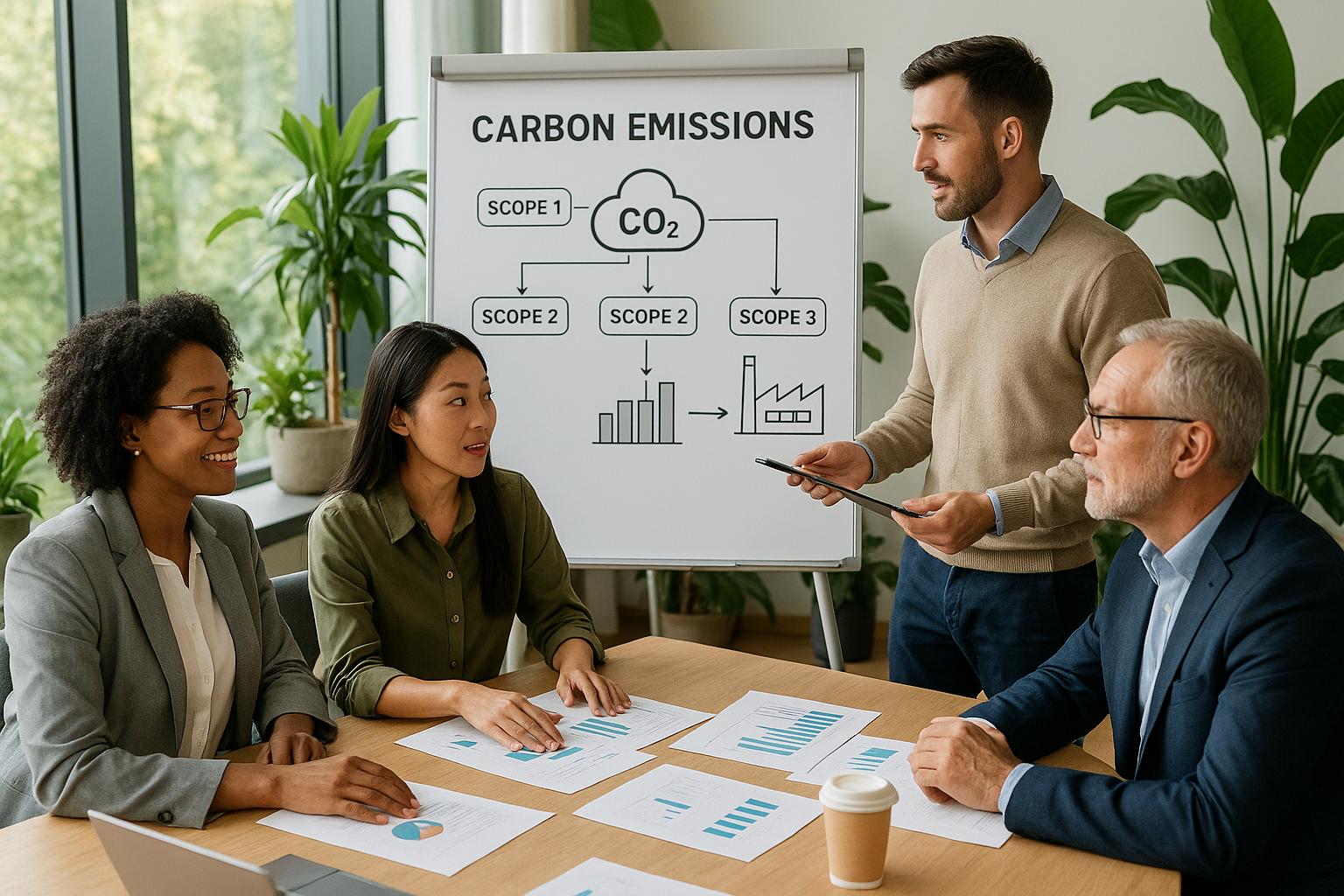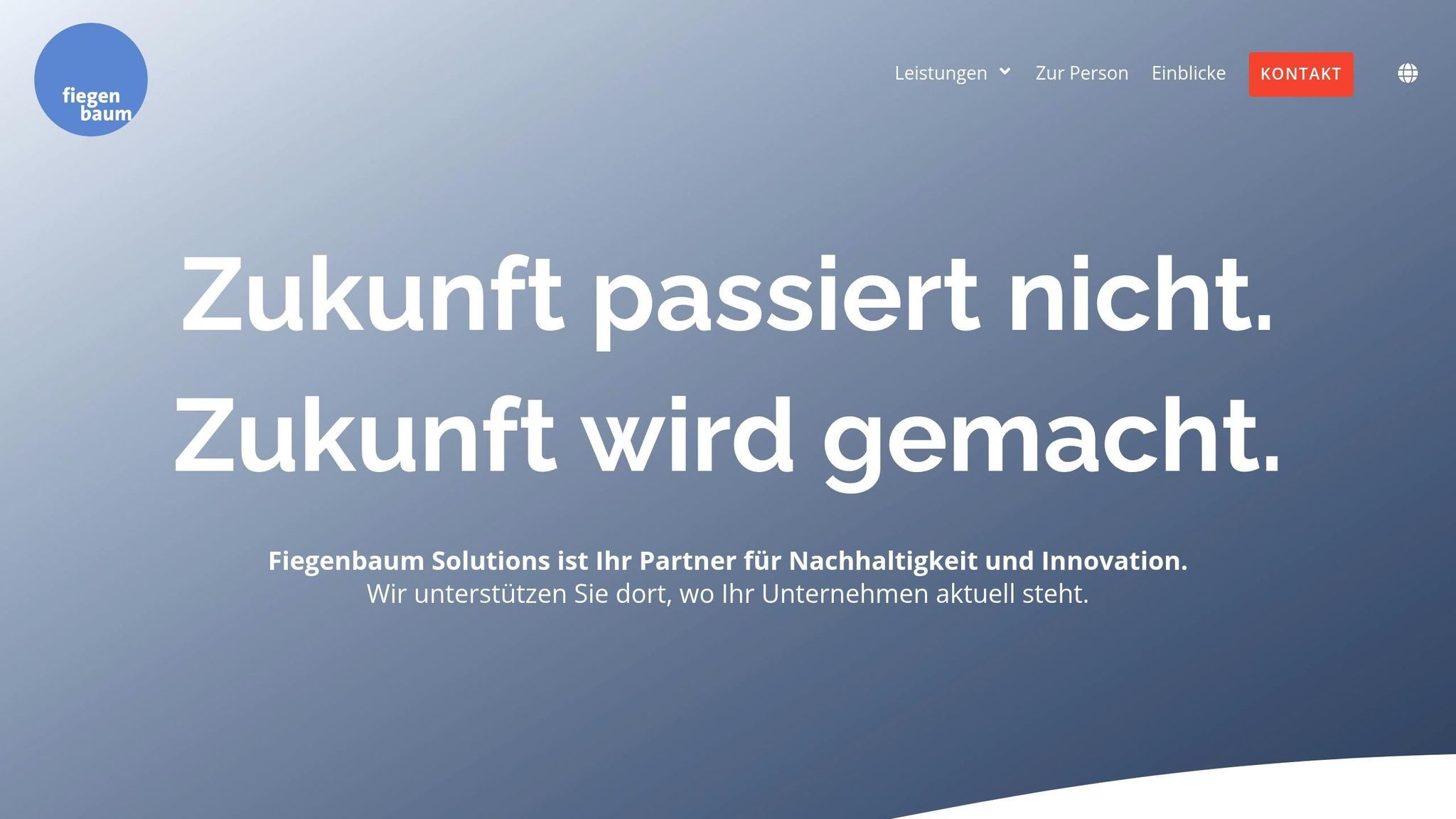A Practical Guide to Science Based Targets Initiative (SBTi) for EU Companies
The Science Based Targets initiative (SBTi) helps companies plan and implement their climate goals...
By: Johannes Fiegenbaum on 7/29/25 8:47 PM

Want to reduce your greenhouse gas emissions and meet the new EU requirements at the same time? Science Based Targets (SBT) provide SMEs with clear guidance to achieve climate goals. In particular, Scope 3 emissions—the indirect emissions along your supply chain—offer huge potential but also pose the greatest challenges. According to the CDP, Scope 3 emissions can account for more than 70% of a typical company’s total carbon footprint, underscoring the importance of addressing these indirect sources (cdp.net). With a structured approach and the right tools, you can master this task. Learn more about Science Based Targets and Scope 3 emissions here.
With clear goals, solid preparation, and supplier engagement, you can improve your CO₂ footprint and secure competitive advantages at the same time. In fact, companies that actively manage and reduce their emissions are more likely to meet evolving regulatory requirements and are increasingly favored by investors and customers (mckinsey.com).
Based on the challenges already described, here is a practical and easy-to-implement guide for small and medium-sized enterprises (SMEs) to account for their Scope 3 emissions. These five steps provide you with clear guidance for successful implementation.
The first step is to determine which of the 15 Scope 3 categories are relevant for your company. Carefully review the description of each category and consult with the responsible people within your organization.
Various criteria play a role in selecting relevant categories, such as the size of the impact, risks, stakeholder expectations, degree of outsourcing, and industry-specific guidelines. Not every category is relevant for every company. However, it is important to provide information for all material categories and to document your reasoning for including or excluding each category.
Assign your business activities to the appropriate categories and prioritize them based on criteria such as volume, impact, and data availability. For example, companies in the manufacturing sector may find that purchased goods and services, as well as transportation, are their most significant Scope 3 categories (ghgprotocol.org).
Data collection is often the most challenging part, as it covers the entire supply chain and numerous suppliers. The best way to start is with spend-based data, internal purchasing data, or industry averages—or a combination of these.
Begin by requesting Product Carbon Footprints (PCFs) from your suppliers and gradually work your way towards more precise primary data. Use quantity-based methods and existing information on purchased materials. Close collaboration with your suppliers can help achieve shared reduction targets. For data gaps in downstream categories, hybrid approaches—a mix of primary data and estimation models—can offer a solution. Explore more about carbon footprint analyses and LCA here.
For emission calculations, the GHG Protocol provides various tools, both cross-industry and industry-specific. The Corporate Value Chain (Scope 3) Standard offers an internationally recognized method for tracking emissions along the value chain.
| Scope 3 Category | Recommended Emission Factor Source |
|---|---|
| 1 (Purchased goods and services) | USEEIO |
| 2 (Capital goods) | USEEIO |
| 3 (Fuel- and energy-related activities) | UK DEFRA, IEA, EPA eGRID |
| 4 (Upstream transportation and distribution) | EF Hub, Table 8 |
| 5 (Waste generated in operations) | EF Hub, Table 9 |
| 6 (Business travel) | EF Hub, Table 10 |
The calculation formula is: Activity Data × Emission Factor. Where possible, you should use local emission factors to improve result accuracy. According to the GHG Protocol, using supplier-specific data is considered best practice and can significantly improve the accuracy of your inventory (ghgprotocol.org).
Thorough documentation is essential for audits, reporting, and communication with stakeholders. Use the Corporate Accounting and Reporting Standard from the GHG Protocol as a guide.
Ensure data quality through plausibility checks, completeness reviews, and consistency checks. Transparently document all assumptions, estimates, and methods. For SMEs, this means keeping all calculation steps, emission factors used, and data sources traceable. This documentation is necessary for both internal reviews and external audits. Learn about third-party ESG audits and documentation here.
If Scope 3 emissions account for 40% or more of your total Scope 1, 2, and 3 emissions, the SBTi requires you to set targets for them. Interestingly, 96% of SBTi-validated targets include Scope 3 emissions (sciencebasedtargets.org).
"When SBTi started in 2015, only a handful of companies had meaningful and comprehensive Scope 3 inventories and targets. Now, every company submitting a target for SBTi validation creates a Scope 3 inventory, and 96% of SBTi-validated targets include Scope 3 emissions."
Define clear and measurable targets and set up a system to continuously monitor your progress. In the next section, you’ll find a practical checklist that summarizes the entire process at a glance. More on Science Based Targets initiative (SBTi) here.
A well-structured checklist helps small and medium-sized enterprises (SMEs) efficiently plan the often complex process of Scope 3 accounting and cover all key steps. The checklist is divided into the following phases: Preparation, Data Collection, Calculation, and Documentation.
| Phase | Task | Responsibility |
|---|---|---|
| Preparation | Identify relevant Scope 3 categories from the 15 available | Sustainability officer with specialist departments |
| Preparation | Document reasoning for included or excluded categories | Sustainability officer |
| Data Collection | Request activity data from suppliers | Purchasing/Procurement |
| Data Collection | Compile internal purchasing and spending data | Controlling/Accounting |
| Calculation | Use GHG Protocol tools or industry-specific templates | Sustainability officer |
| Documentation | Transparent documentation of all assumptions, methods, and data sources | Sustainability officer |
These steps ensure that Scope 3 accounting is carried out completely and transparently. It’s important to understand that creating an accurate Scope 3 emissions inventory is a dynamic process that should be regularly reviewed and improved. As companies in the supply chain increasingly focus on sustainability, SMEs should be prepared to disclose and optimize their practices.
Special attention should be paid to the areas with the highest emissions, as Scope 3 emissions often far exceed a company’s direct emissions. A good starting point is to use estimation methods to identify the most significant Scope 3 activities. According to the World Economic Forum, prioritizing high-impact suppliers can yield the most significant reductions and is a recommended best practice (weforum.org).
Once the prioritized areas are defined and analyzed, practical tools and templates can be used for implementation.
Scope 3 accounting is greatly simplified by using proven tools and templates. Excel-based solutions are a cost-effective option for SMEs. With GHG Protocol templates or industry-specific forms, you can directly record activity data such as fuel consumption, material quantities, or transport distances. These templates often include integrated emission factors or can be expanded with custom factors.
Industry-specific templates provide additional precision in data collection. For example, the electronics industry can use templates from iNEMI and JEITA for component manufacturers. The textile industry can rely on the Higg Index for supply chains, while the construction sector can use tools like the CO₂ Performance Ladder or EN 15804-based LCA tools.
Automated carbon accounting platforms offer a modern alternative by centrally integrating real-time data. These systems simplify data collection and analysis, enabling precise monitoring of CO₂ reduction and compliance with environmental requirements. Learn more about life cycle assessment (LCA) tools and software.
When selecting suitable tools, SMEs should consider which formats are preferred by their customers or industry associations. Collaboration with employees is also crucial to create or adapt a business plan that delivers reliable and up-to-date sustainability data. By analyzing the most emission-intensive business areas, targeted measures for emission reduction can also be developed. For a list of recommended software and templates, see SME Climate Hub Tools.
Scope 3 accounting is one of the most demanding areas in climate management. According to reports, 83% of companies struggle to access relevant emissions data, making implementation even more difficult (cdp.net). Here, we take a look at typical pitfalls and show how to avoid them—in line with the step-by-step guide above.
A major issue in Scope 3 accounting is incomplete data collection along the supply chain. Only 56% of suppliers share emissions data with their business customers. This gap often arises due to limited resources and lack of know-how among suppliers (cdp.net).
Especially small and medium-sized enterprises (SMEs) often rely on spend-based estimates, which can lead to significant inaccuracies. This method should therefore only be a last resort. In addition, entire emission categories are often overlooked when the focus is only on obvious sources.
A sensible approach is to prioritize suppliers with the highest emissions. SMEs can first identify the suppliers that contribute most to the CO₂ footprint and focus on long-term cooperation. Measures such as supplier portals, training, or incentive systems can help improve data quality. This creates a solid Scope 3 inventory.
Once data gaps are closed, another problem needs to be avoided: double counting.
Double counting occurs when the same emissions are recorded multiple times in a CO₂ inventory. The risk is especially high in Scope 3, as these emissions often account for more than 90% of a company’s total scope emissions (cdp.net).
A typical example: A manufacturer might record emissions both in the supply chain and in distribution if these areas are not clearly separated.
To prevent this, SMEs should define clear organizational boundaries. The GHG Protocol provides helpful guidance with its control approaches (equity share or operational control). Close coordination with suppliers and customers is also crucial to avoid overlaps. If potential double counting is identified, clear distinctions between categories help resolve the issue.
In addition to external challenges, internal organization is also a key factor.
An often underestimated problem is the lack of collaboration between departments. Without close coordination, misunderstandings and unclear responsibilities can complicate the entire accounting process.
Many SMEs underestimate how important internal collaboration is for successful CO₂ accounting. To get everyone on board, joint goals—such as savings potential or competitive advantages—should be clearly formulated. Cross-functional teams that integrate the accounting process into daily work can further strengthen this approach.
Transparent communication of reporting boundaries and calculation methods also helps identify overlaps and ensure that only your own emissions are recorded. This is especially important as Scope 3 emissions average 70% of total value chain emissions and are often up to eleven times higher than Scope 1 emissions (cdp.net).
By involving employees in the accounting process, sustainability becomes more deeply rooted in the corporate culture and a fixed part of the business strategy. With these measures, a robust Scope 3 inventory can be created.

Tracking and accounting for Scope 3 emissions is a demanding task, especially for medium-sized companies with limited resources. This is where external support comes in, tailored to these needs and making the process easier.
Fiegenbaum Solutions offers consulting specifically tailored to German SMEs for Scope 3 accounting and the implementation of Science Based Targets (SBT). With solid expertise in life cycle assessments (LCA) and extensive experience in regulatory compliance, the company brings exactly the expertise SMEs need.
A key part of the consulting is developing individual strategies. These ensure that ESG goals are not only formulated but also effectively integrated into business strategy. Johannes Fiegenbaum places particular emphasis on aligning SBTi standard requirements with the economic realities of SMEs.
To put theory into practice, Fiegenbaum Solutions provides a range of customizable tools and templates developed specifically for medium-sized companies. Workshops and webinars on topics such as GHG accounting and reporting standards complement the offering and help build the necessary know-how within the company.
A focus is placed on simplifying data collection. By integrating into existing ERP systems and automated data validation, the effort required for Scope 3 accounting is significantly reduced. In addition, experienced professionals are available to assist with specific questions or challenges. Companies can choose between project-based consulting and long-term retainer agreements to cover either targeted topics such as life cycle assessments or ongoing support in sustainability matters.
Fiegenbaum Solutions takes a holistic approach that goes beyond compliance. The goal is to link climate protection measures with greater resilience and new business opportunities. Sustainability should not just be a cost factor, but a competitive advantage.
This includes climate risk assessments and resilience planning, helping companies prepare for future challenges while unlocking efficiency potential. These measures complement Scope 3 accounting strategies and lay the foundation for net-zero strategies and decarbonization pathways that combine ambitious climate goals with business stability. Learn more about climate risks and business strategies.
With data-driven analysis, Fiegenbaum Solutions helps companies make informed decisions and continuously improve their sustainability strategies. Impact modeling and scenario analysis provide a clear view of the long-term effects of measures and enable targeted planning.
Start-ups also benefit from flexible and transparent pricing models. These ensure that every collaboration is tailored to the specific needs and conditions of each company. This makes sustainability accessible to all—regardless of company size.
The introduction of Science Based Targets and precise Scope 3 accounting means much more than just regulatory compliance for medium-sized companies. Companies that reduce their greenhouse gas emissions based on science not only actively contribute to climate protection but also strengthen their own competitiveness.
The numbers speak for themselves: Sustainability-oriented companies achieve a 20% higher valuation, 55% higher employee motivation, and 16% increased productivity (deloitte.com). These benefits arise when climate protection measures are consistently integrated into business strategy. A practical example shows how this can succeed.
Traceless Materials from Hamburg demonstrates how SMEs can achieve measurable success through comprehensive Scope 3 accounting. The company conducted a scientifically based life cycle assessment and achieved up to 95% fewer greenhouse gas emissions in production and disposal. On average, 2.59 tons of CO₂ equivalent were saved per ton of material.
Those who embrace sustainability early strengthen their market position, increase resilience, and improve brand perception. With 87% of consumers preferring sustainable brands, climate protection is becoming a decisive competitive factor. Discover how branding and sustainability go hand in hand.
Success in Scope 3, however, requires ongoing effort. After the initial accounting, companies should report their emissions annually and track progress. Focus on areas with the greatest savings potential and work closely with suppliers, customers, and other partners.
Expert opinions also underline the importance of clear, science-based target setting. Keiko Shiga from Sony Corporation sums it up:
“A science-based target helps us stay on track. It means we know what we need to do in the short and medium term to achieve the long-term vision. As part of the global initiative, we know we are part of a larger movement.”
To support SMEs in this transformation process, Fiegenbaum Solutions offers hands-on assistance. With the right tools, a clear strategy, and continuous adaptation, Scope 3 accounting becomes a true competitive advantage—not just for regulatory compliance.
SMEs can still improve their Scope 3 accounting even if direct emissions data from suppliers is missing. Estimation methods are available, such as using industry-specific averages or standardized emission factors. Open communication with your suppliers and raising their awareness of sustainability can help improve data quality in the long term. According to the SBTi, even spend-based estimates are acceptable as a starting point, provided companies work to improve data quality over time (sciencebasedtargets.org).
Practical tips for implementation:
Even if not all data is available, companies can achieve results that are traceable and advance their sustainability goals.
For Scope 3 accounting in SMEs, certified software solutions such as those from Plan A, tools based on the GHG Protocol, and free calculators like the SME Climate Hub are extremely useful. These tools make data collection, analysis, and evaluation much easier. In addition, templates for data collection and exchange, such as those available from Cozero, offer practical support.
Integration into existing IT systems is greatly simplified by interfaces and standardized data formats such as ISO 14064 or the Greenhouse Gas Protocol. This allows data to be transferred and processed efficiently, reducing effort and improving accuracy. These solutions are ideal for SMEs as they can be flexibly tailored to specific requirements. For more information, visit smeclimatehub.org/tools.
SMEs can specifically reduce their Scope 3 emissions by taking action along their supply chain. This includes working with environmentally conscious suppliers, optimizing transport routes, or promoting recycling and efficient resource use.
In the long run, this not only leads to cost savings and greater efficiency, but also strengthens the company’s image and customer relationships. Especially in a market increasingly focused on sustainability, this can be a decisive competitive advantage. Learn more about reducing emissions and cost savings.

ESG & sustainability consultant specializing in CSRD, VSME, and climate risk analysis. 300+ projects for companies like Commerzbank, UBS, and Allianz.
More aboutThe Science Based Targets initiative (SBTi) helps companies plan and implement their climate goals...
Want to take your climate goals to the next level? SBTi certification helps companies set...
Startups often fail at CO2 accounting – but there are solutions. Common mistakes like poor data...